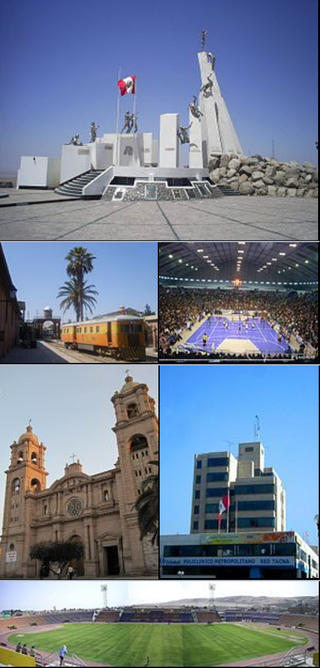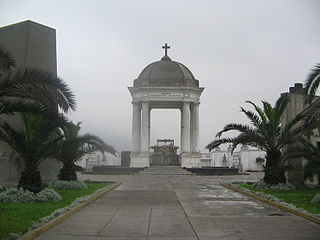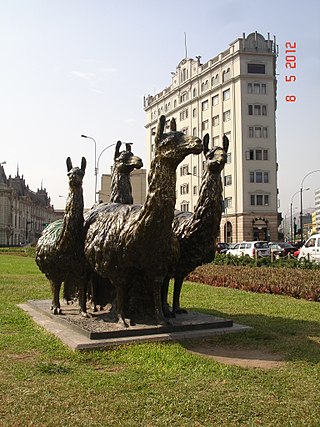
Tacna, officially known as San Pedro de Tacna, is a city in southern Peru and the regional capital of the Tacna Region. A very commercially active city, it is located only 35 km (22 mi) north of the border with Arica y Parinacota Region from Chile, inland from the Pacific Ocean and in the valley of the Caplina River. It is Peru's tenth most populous city.
Chinatowns in Latin America developed with the rise of Chinese immigration in the 19th century to various countries in Latin America as contract laborers in agricultural and fishing industries. Most came from Guangdong Province. Since the 1970s, the new arrivals have typically hailed from Hong Kong, Macau, and Taiwan. Latin American Chinatowns may include the descendants of original migrants — often of mixed Chinese and Latino parentage — and more recent immigrants from East Asia. Most Asian Latin Americans are of Cantonese and Hakka origin. Estimates widely vary on the number of Chinese descendants in Latin America but it is at least 1.4 million and likely much greater than this.

The Palacio de Torre Tagle is a building built during the colonial era of Peru that currently serves as the main headquarters of the Ministry of Foreign Affairs of Peru. It is located in the Jirón Ucayali in the historic center of Lima, two blocks southeast of the Plaza Mayor de Lima.

Presbyter Matías Maestro Cemetery, formerly the General Cemetery of Lima, is a cemetery, museum and historical monument located in the Barrios Altos neighbourhood of Lima District, in Lima, Peru. Inaugurated on May 31, 1808, it was the first pantheon in the city since burials were previously held in the city's churches. It was named in honour of its designer, Spanish priest Matías Maestro.

Chifa is Chinese Peruvian culinary tradition based on Cantonese elements fused with traditional Peruvian ingredients and traditions. The term is also used to refer to restaurants that serve the chifa cuisine.

Barrio chino is a neighborhood in Lima, Peru that is centered on two blocks – 7 and 8 – of Jirón Ucayali in downtown. The neighborhood was founded in the mid-19th century by Chinese immigrants, but it was heavily damaged in the late 19th century by the War of the Pacific and further declined in the following decades. It experienced a revival starting in the 1970s and is now a thriving resource for Chinese-Peruvian culture.
Football is the most popular sport in Peru. Football/soccer in Peru was introduced by British immigrants, Peruvians returning from Great Britain, and by English sailors in the later half of the 19th century during their frequent stops at the port of Callao, which at that point was considered one of the most important ports of the Pacific Ocean. According to the work entitled La Difusión del Fútbol en Lima, during the last decade of the 19th century, records show that sailors were known to practice sports such as football/soccer and played against teams made up of Englishmen, Peruvians, or a mix between Englishmen and Peruvians.

Barrio Chino is a barrio located in the downtown area of Mexico City, near the Palacio de Bellas Artes. The neighborhood is located on two blocks of Dolores Street and consists of a number of restaurants and businesses that import goods. The neighborhood consists of approximately 3,000 families with Chinese heritage in Mexico City.

China–Peru relations are foreign relations between the People's Republic of China and the Republic of Peru. Peru is the first Latin American country that China established formal ties with, which was done by the Qing dynasty in August 1875. Both nations are members of the Asia-Pacific Economic Cooperation and the United Nations.

The Plaza del Vapor was a covered market in Havana, it was completed in 1835. Its name derives from its builder Francisco Martí who became later the impresario of the Tacón Theatre and who had a monopoly of fish trade in the city. Martí had a painting placed against a wall from a bar of the ship El Neptuno, the first vapor that made regular round trips between Havana and Matanzas. "It was the image of that ship that ended up naming the building." From the Plaza del Vapor, Martí sold 50% of all the lottery tickets. in Cuba.

The National Museum of Peru is a national museum in Lurín District, Lima, Peru, located within the archaeological zone of Pachacamac. The museum will hold over a half million artifacts of the Pre-Columbian era and Inca Empire, ranging back to 5,000 BCE. It opened in July 2021 as part of Peru's bicentennial celebrations and is capable of accepting 15,000 guests per day.

The Sesquicentennial of the Independence of Peru took place on July 28, 1971. To commemorate the 150 years of the country's independence from Spain, the Revolutionary Government established two years prior organized a Commission to manage the celebrations and the establishment of new memorials for the duration of the event.

The Monument to Manco Cápac is a statue located in the homonymous square in La Victoria District, Lima, the work of the Peruvian sculptor David Lozano, inaugurated in 1926.

General Felipe Salaverry Avenue is a major avenue in Lima, Peru.

The Moorish Arch, also called the Friendship Arch or Spanish Arch, was a triumphal arch installed at the beginning of Leguía Avenue in Lima, Peru. It was made in a neo-Moorish style, inaugurated in 1924 as part of the Centennial of the Independence of Peru and demolished in 1939.

Alberto Andrade Carmona Park, better known as Love Park, is a public park in Lima, Peru.

Las llamas is a sculpture by Agustín Rivera Eyzaguirre located on the Paseo de los Héroes Navales in Lima, Peru. It was a gift from the Chinese colony in Peru for the fourth centenary of the Spanish foundation of Lima.

La yunta, also known as El trabajo or Los bueyes, is a bronze sculpture in the Paseo de los Héroes Navales, Lima, Peru.

The Quinta Heeren, formerly known as the Quinta del Carmen, is one of the first private residence condominiums built in Lima around the 1880s.



















